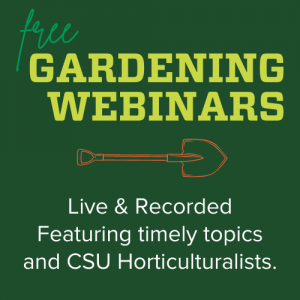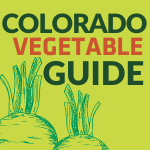GENERAL QUESTIONS
Extra homegrown produce to share? Join our growing network of gardeners in supporting local hunger relief with homegrown produce.
🍅1 – Download the Fresh Food Connect app to connect with your local hunger relief organization
🥬2 – Schedule and track your donations of homegrown produce right through the app, all while simplifying the process for your hunger relief organization
There is no minimum donation requirement. We’re simply hoping you’ll try to grow extra and donate what you can locally.
GROWING QUESTIONS
Awesome! CSU Extension has been helping Coloradans grow for 150 years so we are here to help. Check out the General Gardening Info page on this website for a wide range of resources specific to growing in Colorado. You will also find crop specific information under the Veggies A-Z and the Fruit Crops pages.
Another good resource to help you start growing food for the Grow & Give program is this informational sheet on Great Produce for Giving.
Watering a garden in Colorado comes with some challenges. For more information, see the Water, Fertilizer & Mulch section on our General Gardening Info page.
Generally speaking, it’s best to NOT harvest vegetables during the heat of the day, but instead try to harvest in the morning or evening hours. Harvest into a bucket with water for crops that may be prone to wilting, such as basil. Read your seed packet or the seed label for information on how to tell if your plant is ripe. For more information about harvesting your produce, see the Harvesting Produce section on our General Gardening Info page.
There are a variety of cool season crops that you can grow for a fall harvest. You want to count back from the first frost date (in the fall) to the estimated time to maturity listed on your plant seed package. For more information about planting a fall garden, see the following resource on Growing Cool Season Vegetables from Planttalk. Also, enjoy this video on Planting a Fall Vegetable Garden.
In Colorado, season extension techniques and structures can be very beneficial in helping you to extend the life of your vegetable garden in both the spring and fall. For more information, see our Frost Protection & Season Extension section on our General Gardening Info page.
Hail can be a common occurrence in Colorado and can be devastating to a garden. If you are able, provide a protective cover such as a row cover or garden shade to help protect the plants. Temporary containers such as buckets can work as well but must be removed promptly if the sun comes out. Whether or not your plants will recover after a hailstorm will depend on the severity of the damage to the plants, but they will likely be set back significantly. For more information about how to deal with hail and other weather related issues, see the Environmental Hurdles section on our General Gardening Info page.
Wind can be problematic for many of our plants. Using other stronger plants or structures as a windbreak can be effective to help protect the garden from wind. For more information, see the Environmental Hurdles section on our General Gardening Info page or contact your local county’s CSU Extension Office for additional help.
For more information, see the Water, Fertilizer & Mulch section on our General Gardening Info page.
Identify your weeds first so that you know what type of weed you are trying to manage. In addition, it’s easier to pull weeds before they get big, so monitor your garden frequently. Mulch, either plastic or organic (wood mulch, grass clippings, etc.), can also help to reduce the prevalence of weeds and make those that come up easier to remove.
Here are some resources you may find useful when trying to identify and deal with weeds in a vegetable garden.
GIVING QUESTIONS
Absolutely! You can also backdate donations if you didn’t have time to report earlier in the year.
🍅1 – Download the Fresh Food Connect app to connect with your local hunger relief organization.
🥬2 – Schedule and track your donations of homegrown produce right through the app, all while simplifying the process for your hunger relief organization.
Only donate produce you would consume. Ensure your produce is safe for consumption by reviewing Keeping Your Produce Safe for Donation.
🍅1 – Download the Fresh Food Connect app to connect with your local hunger relief organization
🥬2 – Schedule and track your donations of homegrown produce right through the app, all while simplifying the process for your hunger relief organization
We’re still growing! If we’re not yet connected to a hunger relief operator in your area (here’s our map), please complete this donation form to log your donation. This helps us know where we should look to expand next! App users can also use this form to log donations to friends and family. 💚
There are several things you can do to ensure your homegrown produce is safe for donating. This one-page info sheet is a good place to start: Keeping Your Produce Safe for Donation.
We’re encouraging all Grow & Give gardeners to label their produce with our provided labels so the project will be recognized statewide for our collective donations and impact. Download labels here: Grow & Give Labels.
🍅1 – Download the Fresh Food Connect app to connect with your local hunger relief organization
🥬2 – Schedule and track your donations of homegrown produce right through the app, all while simplifying the process for your hunger relief organization
If we’re not yet connected to a hunger relief operator in your area (here’s our map), please complete this donation form to log your donation. This helps us know where we should look to expand next! App users can also use this form to log donations to friends and family.
When you report, you’re adding your donation to a growing list of statewide donations. Together, we can share the important value local food brings to Colorado. We are simply neighbors helping neighbors.
Our collective efforts will strengthen the program and demonstrate that individual actions and commitment can impact communities positively.
Nope! Fresh Food Connect will share donation information with Grow & Give on the back end!
All gardeners can make a difference! Please do share Grow & Give and Fresh Food Connect with other gardeners in your community. Grow & Give is a Colorado program, but Fresh Food Connect is national, so feel free to spread the word!
Thanks for growing and giving with CSU and Fresh Food Connect!




